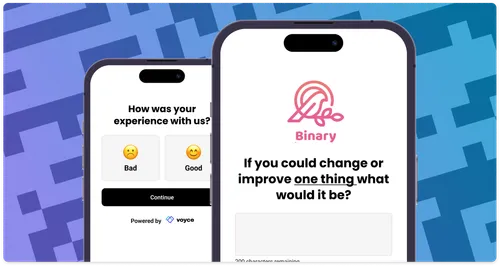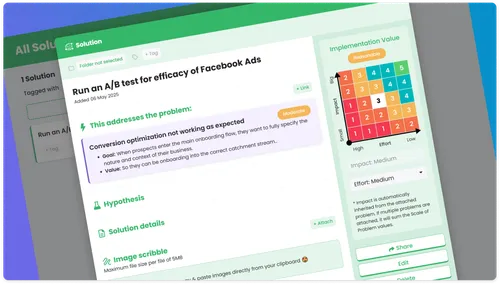14 July, 2025
Stop putting off thinking about customer feedback because you think you need a UX degree to do it properly. Learn three simple practices that will transform how you gather insights - no formal training required.
You know that feeling when you're about to ask a customer for feedback, but you freeze? Maybe you're worried about asking the "wrong" questions. Or you think you need to set up a proper research lab first. Or you're just not sure how to turn their responses into something actionable.
You're not alone. Many founders and product managers have this exact same hesitation. They understand that customer feedback is crucial, but they feel like they need a UX degree or formal research training to do it "properly."
The result? Teams put off feedback gathering entirely, or they collect it informally but never act on it. Meanwhile, they're making product decisions based on assumptions rather than real customer insights. It's a recipe for wasted development cycles, misaligned priorities, and ultimately, customer churn.
But here's the truth: You don't need wireframes, a UX test lab setup, or formal interview training to learn from your customers. The barrier isn't methodology - it's mindset.
The misconception is that valuable customer insights require formal UX research processes. You might think you need to conduct structured interviews, create user personas, or run usability studies.
The reality is much simpler. Often, the most valuable insights come from the small stuff: a quick comment during a demo, an awkward silence when you ask about a feature, or a customer repeatedly mentioning the same workaround.
Imagine a SaaS founder who feels stuck because customers aren’t using a key feature. Instead of hiring a UX researcher, the founder decides to ask a simple question during the next customer call: "What's something that nearly made you not buy our product?"
The answer is immediate and eye-opening: a customer shares that the onboarding process felt overwhelming and that they didn’t know where to start. Acting on this feedback, the team redesigns the onboarding flow, resulting in a significant increase in feature adoption within just a month.
The barrier isn't your lack of UX credentials. It's the belief that feedback needs to be complicated to be valuable.
The good news is that you can start gathering meaningful feedback immediately, without any special training. Here are three simple practices that will transform your feedback game:
Start paying attention to what customers are not saying, and what they're saying between the lines. When a customer pauses before answering a question, that pause often contains more insight than their actual response.
Look for patterns in customer behavior. Are they consistently asking the same questions? Do they seem confused by certain features? Are they using workarounds that suggest they're missing the 'happy path' or struggling to do things the 'wrong way' because your product is confusing?
Consider a scenario where a product team notices that customers keep asking about integration options during sales calls, even though integrations are clearly listed on the website. This pattern reveals that the integration information isn't prominent enough, or maybe customers are looking in the wrong place, or they expect the feature to be more obvious in your application. Whatever the cause and ultimate fix, careful listening can quickly highlight subtle errors that might not be that hard to fix.
Instead of asking generic questions like "How do you like our product?", ask questions that reveal deeper insights. Here are a few simple questions that work remarkably well at uncovering customer sentiment:
These questions often reveal pain points and opportunities that customers might not mention otherwise. They also feel more conversational and less like a formal research interview.
Don't rely on your memory or scattered notes. When you hear something valuable, capture it right away with enough context to make it actionable later.
This is where many teams fall short. They gather great feedback but then lose it in email threads, Slack conversations, or forgotten notebooks. By the time they try to act on it, the context is gone and the insight feels less urgent.
The key is to capture not just what the customer said, but also when they said it, what they were trying to accomplish, and how it relates to your product or business goals.
While these three practices will work with any tool (even a simple notebook), having the right system can make a huge difference. That's why we built Voyce - to make feedback gathering accessible to everyone on your team, not just trained UX researchers.
Instead of inventing your own system for gathering feedback, Voyce provides a pre-built workflow that makes it easy for you to gather feedback directly from your users and customers. Whether you're conducting customer interviews, analyzing support tickets, or reviewing user behavior, adding a new insight takes only a few seconds using a really simple and structured approach.

One of the biggest challenges with feedback is connecting scattered insights to actual problems and solutions, in a way that helps you see the "big picture". Voyce makes it easy to group feedback and related insights together, and link these to problems and solutions so you can see (and remember!) how everything fits together. That comment from a sales call might connect to that support ticket from last week, revealing a larger issue you need to address.

Voyce is built for normal teams, not just designers or researchers. The interface is clean and intuitive, without the overwhelming complexity of traditional research tools. You can start capturing feedback in minutes, not days.
Get insights when they happen, not weeks later. Voyce works across all your customer touchpoints - sales calls, support conversations, user interviews, and more. You can capture feedback immediately and start acting on it right away.
In lots of cases businesses already have the feedback they need. It's scattered across sales calls, support tickets, customer emails, and casual conversations. The challenge isn't always gathering more feedback - it's organizing what you already have and turning it into actionable insights.
With the right mindset and the right tools, you can skip the UX bootcamp and still gather feedback like a pro. The key is to start simple, stay curious, and capture insights when they happen.
If you're curious about an easier way to start gathering and understanding feedback and user insights, you can Try Voyce free for 30 days - no advanced UX degree required! You'll be surprised how much you can learn from your customers when you approach feedback gathering with curiosity rather than intimidation.
Stay in touch for updates and ideas.
No spam. No advertising. No rubbish. Just us.